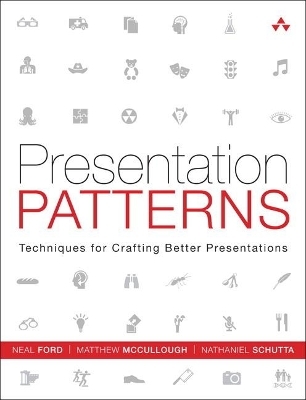
Presentation Patterns
Addison-Wesley Educational Publishers Inc (Verlag)
9780321820808 (ISBN)
- Titel z.Zt. nicht lieferbar
- Versandkostenfrei
- Auch auf Rechnung
- Artikel merken
Patterns are like the lower-level steps found inside recipes; they are the techniques you must master to be considered a master chef or master presenter. You can use the patterns in this book to construct your own recipes for different contexts, such as business meetings, technical demonstrations, scientific expositions, and keynotes, just to name a few.
Although there are no such things as antirecipes, this book shows you lots of antipatterns—things you should avoid doing in presentations. Modern presentation tools often encourage ineffective presentation techniques, but this book shows you how to avoid them.
Each pattern is introduced with a memorable name, a definition, and a brief explanation of motivation. Readers learn where the pattern applies, the consequences of applying it, and how to apply it. The authors also identify critical antipatterns: clichés, fallacies, and design mistakes that cause presentations to disappoint. These problems are easy to avoid—once you know how.
Presentation Patterns will help you
Plan what you’ll say, who you’ll say it to, how long you’ll talk, and where you’ll present
Perfectly calibrate your presentation to your audience
Use the storyteller’s “narrative arc” to full advantage
Strengthen your credibility—and avoid mistakes that hurt it
Hone your message before you ever touch presentation software
Incorporate visuals that support your message instead of hindering it
Create highly effective “infodecks” that work when you’re not able to deliver a talk in person
Construct slides that really communicate and avoid “Ant Fonts,” “Floodmarks,” “Alienating Artifacts,” and other errors
Master 13 powerful techniques for delivering your presentation with power, authority, and clarity
Whether you use this book as a handy reference or read it from start to finish, it will be a revelation: an entirely new language for systematically planning, creating, and delivering more powerful presentations. You’ll quickly find it indispensable—no matter what you’re presenting, who your audiences are, or what message you’re driving home.
Neal Ford is Director, Software Architect, and Meme Wrangler at ThoughtWorks, a global IT consultancy with an exclusive focus on end-to-end software development and delivery. Before joining ThoughtWorks, Neal was the Chief Technology Officer at The DSW Group, Ltd., a nationally recognized training and development firm. Neal has a degree in computer science from Georgia State University, specializing in languages and compilers, and a minor in mathematics, specializing in statistical analysis. He is also the designer and developer of applications, instructional materials, magazine articles, video presentations, and author of six books. His primary consulting focus is the architecture, design, and construction of large-scale enterprise applications. Neal is also an internationally acclaimed speaker, having spoken at more than five hundred developer conferences worldwide, delivering more than two thousand talks. If you have an insatiable curiosity about Neal, visit his website at nealford.com. He welcomes feedback and can be reached at nford@thoughtworks.com, and you can follow him on Twitter at @neal4d. Matthew McCullough is a 15-year veteran of enterprise software development and currently enjoys the role of Vice President of Training at GitHub Inc. He is honored to be part of such an energetic team that is helping advance the software industry to a more collaborative and creative mode of working. Matthew’s past as a co-founder of a U.S. consultancy allowed him to have the job freedom to become a world-traveling open source educator, with the support of many businesses, conference organizers, and friends making it viable. Matthew is a contributing author to the Gradle, Jenkins, and O’Reilly Git books, creator of the Git Master Class series for O’Reilly, speaker on the No Fluff Just Stuff conference tour, author of three of the top 10 DZone RefCards, and volunteer President of the Denver Open Source Users Group. He can be reached via email at matthewm@ambientideas.com or on Twitter at @matthewmccull. Nathaniel Schutta is a senior software engineer in the Twin Cities area of Minnesota with extensive experience developing Java Enterprise Edition based Web applications. He graduated from St. John’s University (MN) with a degree in computer science and has a master’s of science degree in software engineering from the University of Minnesota. For the last several years, he has focused on user interface design. Nathaniel has contributed to corporate interface guidelines and consulted on a variety of web-based applications. A long-time member of the Association for Computing Machinery’s Computer-Human Interaction Special Interest Group and a Sun-certified web component developer, Nathaniel believes that if the user can’t figure out your application, then you’ve done something wrong. Along with his user interface work, Nathaniel is the co-creator of the open-source Taconite framework, has contributed to two corporate Java frameworks, has developed training material, and has led several study groups. During the brief moments of warm weather found in his home state of Minnesota, he spends as much time on the golf course as his wife will tolerate. He’s currently exploring Ruby, Rails, and (after recently making the switch) Mac OS X. Nathaniel is the co-author of the bestselling book, Foundations of Ajax. Nate can be reached via email at ntschutta@gmail.com and on Twitter at @ntschutta.
List of Figures ix
Introduction 1
Origins 2
Toward Patterns 3
How This Book Is Organized 10
How to Use This Book 11
Summary 11
Part I: Prepare 13
Chapter 1: Presentation Prelude Patterns 15
Pattern: Know Your Audience 16
Pattern: Social Media Advertising 18
Pattern: Required 20
Pattern: The Big Why 22
Pattern: Proposed 24
Antipattern: Abstract Attorney 26
Chapter 2: Creativity Patterns 29
Pattern: Narrative Arc 30
Pattern: Fourthought 34
Pattern: Crucible 38
Pattern: Concurrent Creation 41
Pattern: Triad 43
Pattern: Expansion Joints 45
Pattern: Talklet 46
Pattern: Unifying Visual Theme 48
Pattern: Brain Breaks 51
Antipattern: Alienating Artifact 53
Antipattern: Celery 56
Pattern: Leet Grammars 58
Pattern: Lightning Talk 59
Pattern: Takahashi 60
Pattern: Cave Painting 62
Part II: Build 65
Chapter 3: Slide Construction Patterns 67
Antipattern: Cookie Cutter 68
Pattern: Coda 70
Antipattern: Injured Outlines 71
Pattern: Peer Review 72
Pattern: Foreshadowing 75
Antipattern: Bullet-Riddled Corpse 77
Pattern: Greek Chorus 80
Antipattern: Ant Fonts 81
Antipattern: Fontaholic 83
Antipattern: Floodmarks 86
Antipattern: Photomaniac 89
Pattern: Composite Animation 92
Pattern: Á la Carte Content 95
Pattern: Analog Noise 99
Pattern: Vacation Photos 104
Pattern: Defy Defaults 106
Antipattern: Borrowed Shoes 108
Chapter 4: Temporal Patterns 111
Antipattern: Slideuments 112
Pattern: Infodeck 114
Pattern: Gradual Consistency 116
Pattern: Charred Trail 120
Pattern: Exuberant Title Top 123
Pattern: Invisibility 127
Pattern: Context Keeper 131
Pattern: Breadcrumbs 133
Pattern: Bookends 135
Pattern: Soft Transitions 137
Pattern: Intermezzi 139
Pattern: Backtracking 141
Pattern: Preroll 142
Pattern: Crawling Credits 143
Chapter 5: Demonstrations versus Presentations 145
Pattern: Live Demo 147
Antipattern: Dead Demo 151
Pattern: Lipsync 154
Pattern: Traveling Highlights 157
Pattern: Crawling Code 162
Pattern: Emergence 164
Pattern: Live on Tape 165
Part III: Deliver 169
Chapter 6: Stage Prep 171
Pattern: Preparation 172
Pattern: Posse 174
Pattern: Seeding Satisfaction 175
Pattern: Display of High Value 177
Antipattern: Shortchanged 181
Chapter 7: Performance Antipatterns 183
Antipattern: Hiccup Words 184
Antipattern: Disowning Your Topic 186
Antipattern: Lipstick on a Pig 187
Antipattern: Tower of Babble 188
Antipattern: Bunker 190
Antipattern: Hecklers 191
Antipattern: Going Meta 193
Antipattern: Backchannel 195
Antipattern: Laser Weapons 197
Antipattern: Negative Ignorance 199
Antipattern: Dual-Headed Monster 200
Chapter 8: Performance Patterns 203
Pattern: Carnegie Hall 204
Pattern: Emotional State 207
Pattern: Breathing Room 208
Pattern: Shoeless 209
Pattern: Mentor 210
Pattern: Weatherman 211
Pattern: Seeding the First Question 214
Pattern: Make It Rain 215
Pattern: Entertainment 216
Pattern: The Stakeout 218
Pattern: Lightsaber 219
Pattern: Echo Chamber 221
Pattern: Red, Yellow, Green 222
Conclusion 225
Patterns Redux 225
Build Your Own . . . 226
Summary 228
Glossary of Patterns 229
Resources 241
Credits 243
Notes 251
Index 255
| Erscheint lt. Verlag | 6.9.2012 |
|---|---|
| Verlagsort | New Jersey |
| Sprache | englisch |
| Maße | 181 x 216 mm |
| Gewicht | 536 g |
| Themenwelt | Informatik ► Office Programme ► Powerpoint |
| Wirtschaft ► Betriebswirtschaft / Management | |
| ISBN-13 | 9780321820808 / 9780321820808 |
| Zustand | Neuware |
| Informationen gemäß Produktsicherheitsverordnung (GPSR) | |
| Haben Sie eine Frage zum Produkt? |
aus dem Bereich


